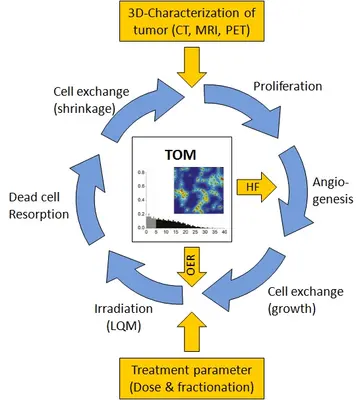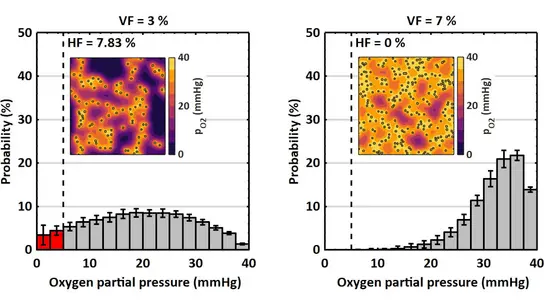Radiobiological Modeling

Hypoxia is one of the most important resistance factors in radiotherapy and correctly predicting the response of hypoxic tumors would allow optimizing the spatio-temporal dose distribution to obtain improved clinical results. Our group developed a tumor oxygenation model (TOM) describing the microscopic oxygen distribution based on intravascular oxygen tension, vascular fraction and vascular architecture. Based on the TOM, a tumor response model (TRM) has been developed describing the impact of proliferation, angiogenesis, tumor growth, irradiation, cell resorption and tumor shrinkage on the spatio-temporal tumor development. Currently, these models are validated using 3D vascular architectures (TOM) and dose response curves (TRM) obtained from preclinical tumors. Additional studies aim to model hypoxic tracer uptake and adaptive radiotherapy strategies.

Selected publications
- Paredes-Cisneros I., Karger, C.P.; Caprile P., Nolte D., Espinoza I., Gago-Arias A.: Simulation of hypoxia PET tracer uptake in tumours: dependence of clinical uptake-values on transport parameters and arterial input function. Physica Medica 70, 109-117, 2020 https://www.sciencedirect.com/science/article/pii/S1120179720300144?via%3Dihub
- Gago-Arias M.A., Sánchez-Nieto B., Espinoza I., Karger C.P., Pardo-Montero J.: Impact of different biologically-adapted radiotherapy strategies on tumor control evaluated with a tumor response model. PLoS One 13, e0196310, 2018 https://journals.plos.org/plosone/article?id=10.1371/journal.pone.0196310
- Espinoza I., Peschke P., Karger C.P.: A voxel-based multi-scale model to simulate the radiation response of hypoxic tumors. Medical Physics 42, 90-102, 2015 https://aapm.onlinelibrary.wiley.com/doi/full/10.1118/1.4903298
- Espinoza I., Peschke P., Karger C.P.: A model to simulate the oxygen distribution in hypoxic tumors for different vascular architectures. Medical Physics 40, 081703, 2013 https://aapm.onlinelibrary.wiley.com/doi/full/10.1118/1.4812431
Get in touch with us
